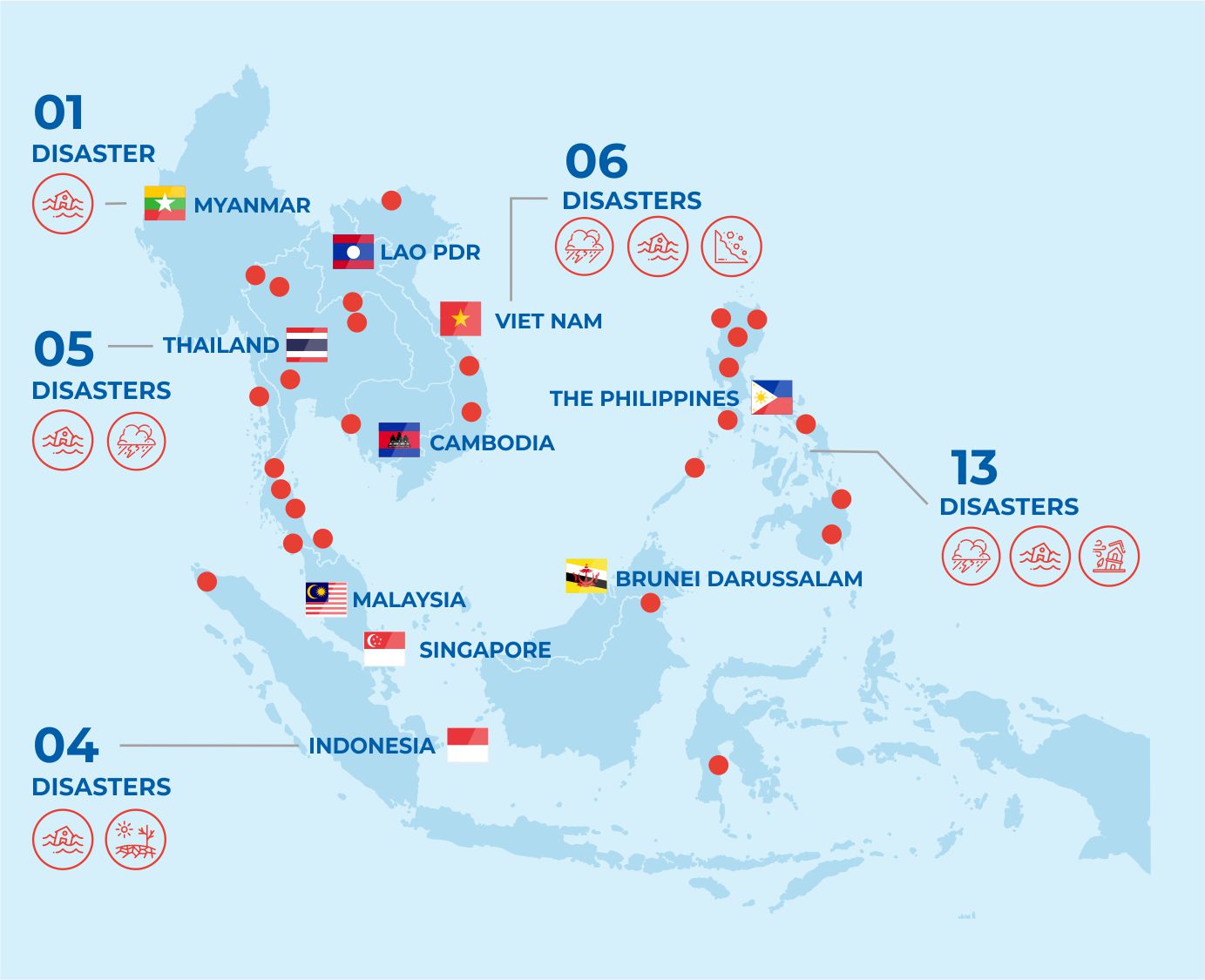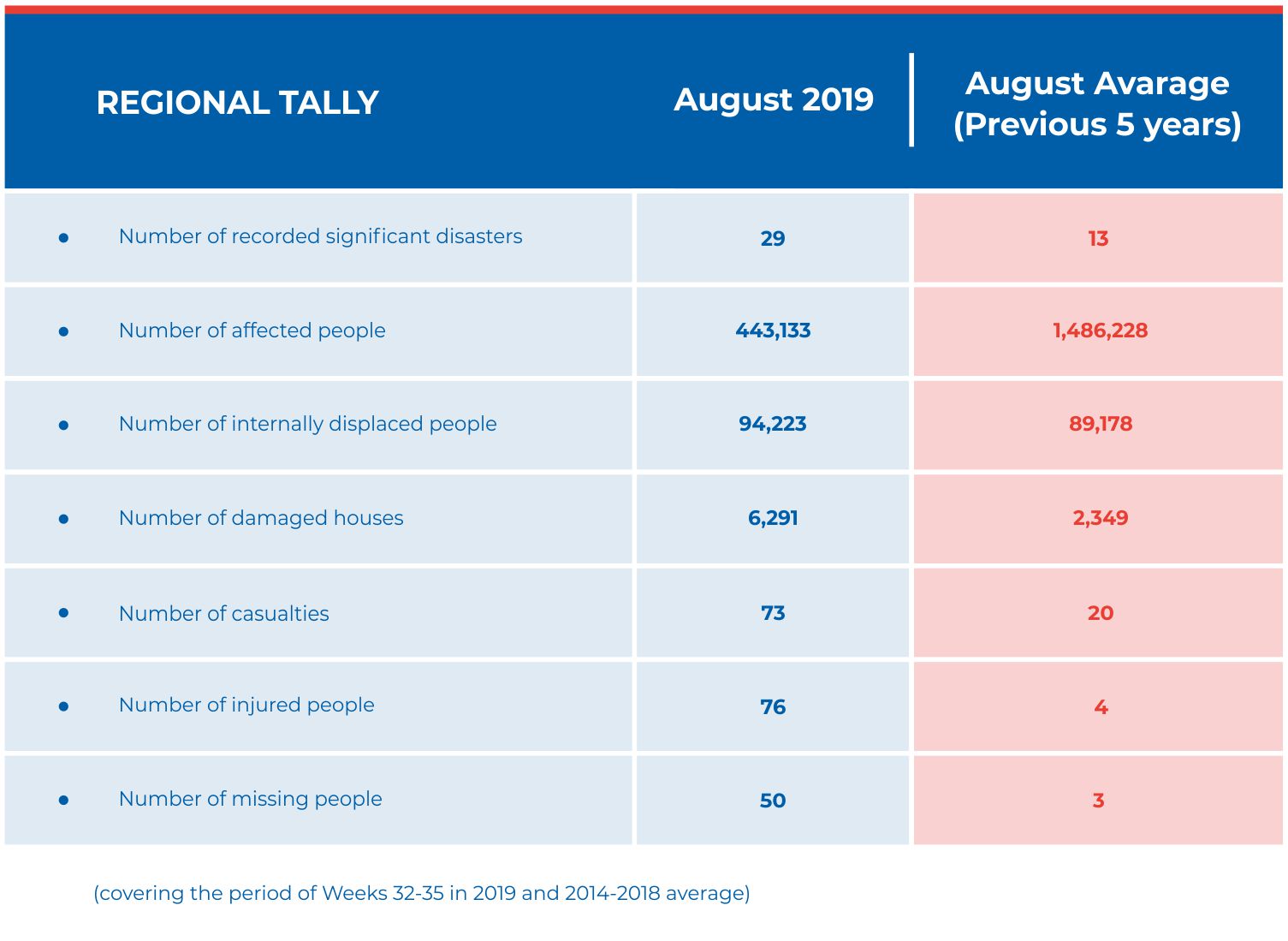
MONTHLY DISASTER REVIEW AND OUTLOOK
AUGUST 2019 | DISASTER MONITORING & ANALYSIS
(DMA) UNIT, AHA CENTRE
GENERAL REVIEW OF AUGUST 2019
The total number of disasters during August 2019 was almost two times higher than the previous five-year average for August, potentially due to the existence of several low pressure systems that resulted in floods. Previously, a majority of floods were caused by the Southwest Monsoon rainfall. However, the total number of affected people during this month was only about 30% of the five-year average, possibly due to the significant size of previous disasters during the month of August. For example, the 2013 Tropical Storm Trami in the Philippines, and the 2018 earthquake in Lombok, Indonesia, each affected more than 3 million people. In addition, several massive floods occurred during August 2018 in the Philippines affecting another 3 million people, as a result of several tropical storms including Soulik, Karding, and Luis. On the other hand, the casualty figures for August 2019 were much higher than the five-year averages (with the number of deaths more than three times higher), primarily as a result of the deadly landslide that occurred in Paung Township (Mon State) during the Myanmar floods that was caused by monsoonal rains.
During August 2019 there were 29 earthquakes of at least magnitude 5.0 recorded in Indonesia, Myanmar and the Philippines, but these events caused no more than minor damage. In addition, several earthquake swarms were reported during August 2019 on Java island, Indonesia, near to the Indonesian volcanic arc formed from subduction interaction between the Indo-Australian plate and the Eurasian plate.
SEASONAL OUTLOOK
According to the ASEAN Specialised Meteorological Centre (ASMC), the Southwest Monsoon season typically persists until October, meaning the northern ASEAN region will likely continue to experience the rainy season, while dry conditions should continue to prevail over the southern ASEAN region. However, inter-monsoon conditions are forecast to start in late October, and are typically characterised by light and variable winds, including an increase in shower activities over the southern ASEAN region. In addition, above-average temperatures during the next three months of 2019 are expected over most parts of the ASEAN region, except for south of the equator, where near-average or below-average temperatures will likely occur. With drier-than-usual conditions forecast to persist over many parts of the southern ASEAN region, hotspot activities in the fire-prone Indonesian provinces of Sumatra and Kalimantan may escalate, and could lead to an increased risk of transboundary haze occurrence. While in the northern ASEAN region, hotspot activities are expected to remain generally subdued due to rainy weather.
To further develop and strengthen coordination to deal with the transboundary natural hazards in the ASEAN region – such as floods, droughts, and tropical cyclones – the AHA Centre participated in the 8th ASEAN Committee on Disaster Management (ACDM) Working Group on Risk Assessment and Awareness (WG RAA) meeting held back to back with the Expert Dialogue on Scaling up Regional Cooperation in Multi-hazard Early Warning Systems in Asia-Pacific. This took place on the last week of August 2019 in Bangkok, Thailand, organised by the ASEAN Secretariat and co-organised by the United Nations Economic and Social Commission for Asia and the Pacific (UNESCAP).
Data Sources: ASEAN Disaster Information Network, ASEAN Specialised Meteorological Centre
Written by : Lawrence Anthony Dimailig, Shahasrakiranna, and Justin Chin Jin Jie
DISCLAIMER
Disclaimer: AHA Centre’s estimation is based on data and information shared by National Disaster Management Organisations (NDMOs) and other relevant agencies from ASEAN Member States, international organisations and news agencies. Further information on each recorded-significant disaster, description and detail of data and information are available at: http://adinet.ahacentre.org/reports.



